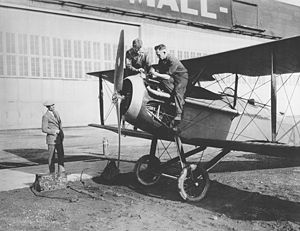Vought VE-7
| VE-7 "Bluebird" | |
|---|---|

| |
| Mechanics work on a VE-7 | |
| Role | Fighter and trainer |
| Manufacturer | Lewis & Vought Corporation
|
| Designer | Chance M. Vought |
| First flight | 1917 |
| Introduction | 1922 |
| Retired | 1928 |
| Primary users | United States Navy United States Army Air Service |
| Produced | 1918-1928 |
| Number built | 128 |
The Vought VE-7 "Bluebird" was an early biplane of the United States. First flying in 1917, it was designed as a two-seat trainer for the United States Army, then adopted by the United States Navy as its first fighter aircraft. In 1922, a VE-7 became the first airplane to take off from an American aircraft carrier.[1]
Design and development
The
However, the Navy was very interested in the VE-7, and received the first machine in May 1920. Production orders soon followed, and in accordance to Navy policy at the time, examples were also built by the Naval Aircraft Factory. In all, 128 VE-7s were built.[1]

The fighter version of the VE-7 was designated VE-7S. It was a single-seater, the front cockpit being faired over and a .30 in (7.62 mm)
The Bluebird won the 1918 Army competition for advanced training machines.[2]
The VE-8 variant completed in July 1919 had a
The VE-9 variant, first delivered to the Navy on 24 June 1922, was essentially an improved VE-7, with most of the improvements in the fuel system area. Four of the 21 ordered by the U.S. Navy were unarmed observation float seaplanes for battleship catapult use.[3]
Operational history

The VE-7s equipped the Navy's first two fighter squadrons VF-1 and VF-2. A VE-7 flown by Lieutenant Virgil C. Griffin made history on October 17, 1922, when it took off from the deck of the newly commissioned carrier Langley. The VE-7s were the Navy's frontline fighters for several years, with three still assigned to the Langley in 1927; all were retired the following year.[1]
Variants

- VE-7 (1918) - 14 built for the U.S. Army Air Service; 39 built for the U.S. Navy; (one of two known, built at McCook Field. Reportedly four more were built by Springfield Co)
- VE-7F (1921) - 29 built for the U.S. Navy
- VE-7G (1921) - One converted from VE-7 for U.S. Marine Corps, 23 converted from VE-7 for U.S. Navy
- VE-7GF (1921) - One converted from VE-7
- VE-7H (1924) - Nine observation seaplanes built for the U.S. Navy
- VE-7S (1925) - One converted from VE-7
- VE-7SF (1925) - 11 built for the U.S. Navy
- VE-7SH - One VE-7SF converted into a floatplane.
- VE-8 (1918) - Four ordered by the U.S. Army on October 11, 1918; two were canceled; 340 hp Wright-Hispano H engine installed, two Vickers guns, wingspan decreased to 31 ft (9.4 m), wing area increased to 307 sq ft (28.5 m2), shortened to 21 ft 4 in (6.50 m), speed increased to 140 mph (230 km/h), loaded weight increased to 2,435 lb (1,104 kg)[3]
- VE-9 (1921) - Two converted from VE-7 for U.S. Army; speed increased to 119 mph (192 km/h), service ceiling increased to 18,840 ft (5,740 m)
- VE-9 (1927) - 22 built for the U.S. Army, 17 built for the U.S. Navy. (U.S. Army used same designation as U.S. Navy)
- VE-9H (1927) - Four unarmed observation float seaplanes built for the U.S. Navy battleships, modified vertical tail surfaces for improved catapult and water stability[3]
- VE-9W - canceled
Surviving aircraft
No survivors remain, however a replica Bluebird was completed in early 2007 by volunteers of the Vought Aircraft Heritage Foundation.
Operators
Specifications (VE-7)

Data from Janes Fighting Aircraft of World War I by Michael John Haddrick Taylor (Random House Group Ltd. 20 Vauxhall Bridge Road, London SW1V 2SA, 2001,
General characteristics
- Crew: two
- Length: 24 ft 5.375 in (7.45 m)
- Wingspan: 34 ft 4 in (10.47 m)
- Height: 8 ft 7.5 in (2.63 m)
- Wing area: 284.5 sq ft (26.43 m2)
- Airfoil: RAF-15[6]
- Empty weight: 1,392 lb (631 kg)
- Gross weight: 1,937 lb (879 kg)
- Powerplant: 1 × Wright-Hispano E-3 liquid cooled V-8, 180 hp (134 kW)
- Propellers: 2-bladed, 8 ft 8 in (2.64 m) diameter wooden fixed pitch propeller
Performance
- Maximum speed: 106 mph (171 km/h, 92 kn)
- Range: 290 mi (467 km, 250 nmi)
- Service ceiling: 15,000 ft (4,600 m)
- Rate of climb: 738 ft/min (3.75 m/s)
Armament
- Guns: (VE-7S) 1 x .30 in (7.62 mm) Vickers machine gun machine gun synchronized to fire through the propeller
References
Notes
- ^ ISBN 0-8168-9254-7), pp. 11-13]
- ISBN 1-85170-347-0), page 252.
- ^ ISBN 0-7607-0904-1), pp. 336-337
- ^ Vought Aircraft Heritage Foundation
- ^ "VE-7 Bluebird". History.navy.mil. 1922-10-17. Retrieved 2022-05-02.
- ^ Lednicer, David. "The Incomplete Guide to Airfoil Usage". Retrieved 16 April 2019.
Bibliography
- Millot, Bernard (October 1971). "Lewis-Vought VE.8 ou le malchanceux "Spad" americain" [Lewis-Vought VE.8 or the unlucky American "Spad"]. Le Album de Fanatique de l'Aviation (in French) (26): 2–3. ISSN 0757-4169.
- K.O. Eckland's Aerofiles; accessed 13 May 2007
